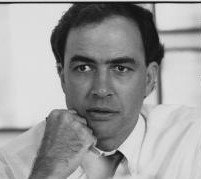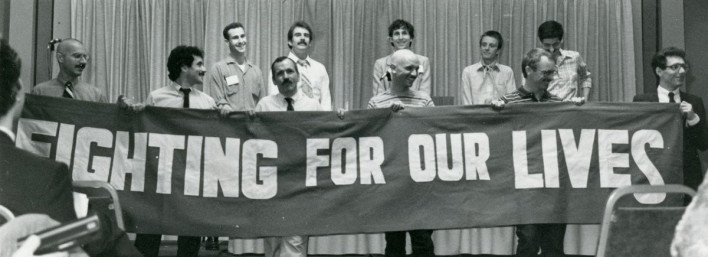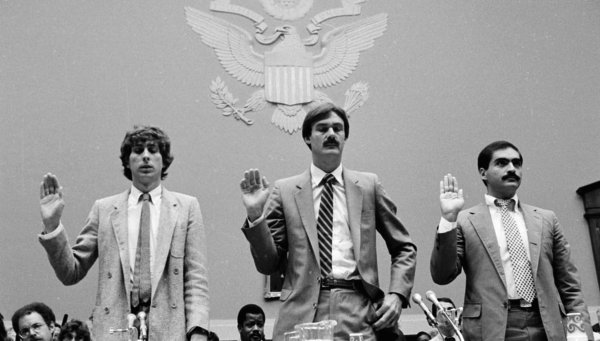
1983
PDF last updated on June 8, 2021.
Documentation for all entries can be found in the PDF.
For additional information on words in bold italic, check the Glossary.
January 1 : Ward 86 , the world’s first dedicated outpatient AIDS clinic, opens at San Francisco General Hospital. The clinic is a collaboration between the hospital and the University of California, San Francisco (UCSF), and it draws staff who are passionate about treating people with AIDS. Over time, the staff develop the San Francisco Model of Care , which emphasizes treating patients with compassion and respect; providing an array of health and social services in one facility; and collaborating closely with the local health department and community organizations. The model eventually becomes the global gold standard for HIV patient care.
San Francisco General Hospital, Building 80—Home of Ward 86
Photo credit: UCSF
January 4: The Centers for Disease Control (CDC) hosts a public meeting to identify opportunities to protect the nation’s blood supply from AIDS. The meeting is heated as representatives from the blood banks, the hemophilia and gay communities, and federal staff from the Food and Drug Administration (FDA) and the National Institutes of Health (NIH) respond negatively to CDC’s urgent plea to either begin testing donor blood for hepatitis B as a proxy for the virus they believe is causing AIDS or asking gay men to refrain from donating blood. Participants fail to reach consensus on appropriate action. This will have devastating effects for people living with hemophilia and individuals who need blood transfusions and lead to a spate of lawsuits against the blood-banking industry.
The CDC meeting on January 4, 1983.
Photo credit: Sarah Leen, Philadelphia Inquirer
CDC epidemiologist Dr. Donald Francis asking how many people have to die before the blood banking industry will take the threat of AIDS in the blood supply seriously?
Photo credit: Sarah Leen, Philadelphia Inquirer
January 7 : CDC reports the first cases of AIDS in women who are the sexual partners of men with AIDS: Epidemiologic Notes and Reports Immunodeficiency among Female Sexual Partners of Males with Acquired Immune Deficiency Syndrome (AIDS) -- New York .
Dr. Françoise Barré-Sinoussi
Photo credit: Unknown
January 23 : Dr. Françoise Barré-Sinoussi , a 34-year-old virologist at the Pasteur Institute in Paris, discovers that the viral specimen taken from the lymph node of a white male patient with symptoms of AIDS is a lethal retrovirus. She is the first person to identify the retrovirus because she has taken the unusual step of adding new lymphocytes (a type of white blood cell) to her lab cultures on a regular basis. Because the as-yet-unidentified retrovirus is so incredibly efficient at killing white blood cells, it dies if not fed regularly. Barré-Sinoussi discovers what scientists at CDC and NIH miss because—although they also suspect a retrovirus is the cause of AIDS—they base their experiments on the behavior of the first human retrovirus, human T-cell lymphotropic virus Type I (HTLV-I), which causes a proliferation of white blood cells in cultures. Since they are not adding new lymphocytes, their viral samples keep dying.
February 18 : Steven Lawrence Walitsch, the San Francisco toddler who was the first confirmed case of transfusion-related AIDS, dies 16 days before his second birthday.
February 19 : Researchers at the University of California, Davis, report that they have identified a syndrome closely resembling AIDS in a group of 64 rhesus monkeys at the California Primate Research Center. Later in the year, scientists at Harvard Medical School will report similar results in macaques .
March 4 : CDC’s MMWR article, Current Trends Prevention of Acquired Immune Deficiency Syndrome (AIDS): Report of Inter-Agency Recommendations , notes that most cases of AIDS have been reported among gay men with multiple sexual partners, people who inject drugs, Haitians, and people with hemophilia. The report suggests that AIDS may be caused by an infectious agent that is transmitted sexually or through exposure to blood or blood products and issues recommendations for preventing transmission.
March 13 : AIDS activist Larry Kramer publishes a blistering assessment of the impact of AIDS on the gay community in the New York Native . The essay, 1,121 and Counting , is a frantic plea for the community to get angry at the lack of government support for sick and dying gay men and the slow pace of scientific progress in finding the cause of AIDS.
The article that shook the New York gay community
Photo credit: New York Native
March 14 : AIDS Project Los Angeles is officially incorporated.
April 25 : The British Broadcasting Company (BBC) premiers a documentary on the AIDS epidemic in the United States: Killer in the Village. The film provides commentary from some of the physicians who were the first to identify cases of AIDS among gay men in New York (Linda Laubenstein, Alvin Friedman-Kien) and San Francisco (Paul Volberding), as well as in children in New Jersey (James Oleske).
Dr. Linda Laubenstein
Dr. Alvin Friedman-Kien, 1983
Dr. Paul Volberding
April 27 : Dr. Matilde Krim, Dr. Joseph Sonnabend, Nobel-prize winning scientist Dr. David Baltimore, singer and AIDS activist Michael Callen, and philanthropist Mary Lasker join together to create the AIDS Medical Foundation, the first private organization dedicated to comprehensive AIDS research. The foundation is created to provide seed money to researchers and scientists with promising AIDS-related projects who have been turned down for scarce government grants. Krim puts up $100,000 of her own money to start it. Because of the stigma attached to AIDS, the Foundation cannot list its full name on the lobby signage in the building that houses its office.
Richard Berkowitz and Michael Callen working on How to Have Sex in an Epidemic: One Approach, Photo credit: Richard Dworkin
May : Richard Berkowitz and Michael Callen—both men living with AIDS—publish a booklet on “safer sex” titled How to Have Sex in an Epidemic: One Approach . It advocates for gay men to have fewer sexual partners and use condoms; it also focuses on self-empowerment for those living with AIDS. Printing was funded by a $5,000 donation from philanthropist and AIDS activist Randall Klose and Callen’s IRS tax refund.
May 2 : The Kaposi’s Sarcoma Foundation sponsors the first AIDS candlelight vigils . Ten thousand people turn out for the San Francisco march; 5,000 turn out for the march in New York. There are also marches in Los Angeles, Chicago, and Houston. It is the first time that people with AIDS come together in public demonstrations. Photos of the events are circulated around the world—shedding some of the first light on the growing health crisis and humanizing those who are affected.
Poster for the bi-coastal AIDS Candelight March on May 2, 1983. Designed & illustrated by David Emfinger
Unknown drummer at NYC Candelight March on May 2, 1983 Photo credit: Richard Wandell
May 20 : Dr. Françoise Barré-Sinoussi and her colleagues at the Pasteur Institute in France publish the first scientific paper to report the discovery of a retrovirus that could be the cause of AIDS .In 2008, she will be awarded the Nobel Prize in Medicine for this discovery, along with the director of her lab, Dr. Luc Montagnier .
May 25 : The New York Times publishes its first front-page story on AIDS : “Health Chief Calls AIDS Battle ‘No. 1 Priority’.” The article reports on the federal response to the growing AIDS epidemic.
June 1: Marchers at Gay Pride parade in Manhattan.
June 12 : Eleven gay men living with AIDS take over the plenary stage at the National AIDS Forum in Denver. They issue a statement on the rights of people living with AIDS to be at the table when policy is made, to be treated with dignity, and to be called “people with AIDS,” not “AIDS victims.” The statement becomes known as The Denver Principles [PDF, 19KB], and it serves as the charter for the founding of the National Association of People with AIDS.
Denver Principles authors. First row, L to R: Phil Lanzaratta, Richard Berkowitz, Tom Nasrallah, Matthew Sarner, Bobby Reynolds, Artie Felson. Back row, L to R: Bill Burke, Dan Turner, Michael Callen, Bobbi Campbell, Bob Checci Photo credit: POZ
June 26: Members of the People with AIDS Alliance march in the San Francisco Gay Pride Parade.
July 1 : The U.S. Public Health Service opens the National AIDS Hotline to respond to public inquiries about the disease. The first day, the phone line has 13,000 callers. By July 28, the hotline has to be expanded from three phonelines to eight, because 8,000-10,000 callers are phoning daily.
July 25 : After a petition by psychiatric nurse Cliff Morrison , San Francisco General Hospital opens Ward 5B , the first dedicated in-patient AIDS ward in the U.S. Within days, its 12 beds are fully occupied. The ward is run by Morrison and an all-volunteer staff—from nurses to janitors—who offer compassionate, holistic care for AIDS patients.
August : The National Institute of Allergy and Infectious Diseases begins publishing an informal newsletter, the AIDS Memorandum, through which scientists can share unpublished research findings. This publication lasts for two years, until mainstream scientific journals begin expediting publication for articles on AIDS.
August 1-2: The U.S. House of Representatives Subcommittee on Government Operations holds hearings on the federal response to AIDS. The members invite three men, Michael Callen (New York), Roger Lyon (San Francisco), and Anthony Ferrara (Washington, DC), to open the hearing by testifying about their experiences living with AIDS. Lyon ends his testimony with a plea to members of Congress: “…this is not a political issue. This is a health issue. This is not a gay issue. This is a human issue. And I do not intend to be defeated by it. I came here today in the hope that my epitaph would not read that I died of red tape.”
L to R: Michael Callen, Richard Lyon, and Anthony Ferrara testify at congressional hearings on the federal response to AIDS, August 1, 1983 Photo credit: AP
August 8: AIDS activist Bobbi Campbell appears with his partner, Bobby Hilliard, on the cover of Newsweek magazine for the story, “Gay America: Sex, Politics, and the Impact of AIDS.” It is the first time two gay men are pictured embracing one another on the cover of a U.S. mainstream national magazine.
Bobbi Campbell and his lover, Bobby Hilliard, Photo credit: Newsweek
September 2: In response to growing concerns about the potential for transmission of AIDS in healthcare settings, CDC publishes the first set of occupational exposure precautions for healthcare workers and allied health professionals.
September 9: In its latest edition of the MMWR, “Current Trends Update: Acquired Immunodeficiency Syndrome (AIDS) -- United States,” CDC identifies all major routes of HIV transmission—and rules out transmission by casual contact, food, water, air, or environmental surfaces.
Washington Blade, September 30, 1983
September 28: The D.C. Coalition of Black Gays and the Whitman-Walker Clinic host a forum on AIDS specifically for Black men”) —possibly the first event of its kind. The event, advertised as an “AIDS Forum for Black and Third-World Gays” is held at the ClubHouse nightclub—a fixture in Washington for Black same-sex desiring men. Forty people attend the forum and during a presentation on the symptoms of Kaposi's Sarcoma, attendees note that the slides largely depict KS lesions on white skin—demonstrating the significance of the visual in making AIDS recognizable as a disease affecting Black people.
September 30: After New York City physician Joseph Sonnabend is threatened with eviction from his office building for treating patients with AIDS, the state’s Attorney General and Lambda Legal join together to file the first AIDS discrimination lawsuit, People v. West 12 Tenants Corp.
Schedule for the AIDS: Practical Considerations for the Primary Care Physician conference, October 22, 1983
October 22: The International Center for Interdisciplinary Research on Immunologic Diseases at Georgetown University School of Medicine and the NIH National Institute of Allergy and Infectious Diseases host a conference, AIDS: Practical Considerations for the Primary Care Physician (PDF, 750KB).
November 22-25: The World Health Organization holds its first meeting to assess the global AIDS situation and begins international surveillance.
December 2: CDC releases a new MMWR, Current Trends Update: Acquired Immunodeficiency Syndrome (AIDS) among Patients with Hemophilia -- United States.
December 22: CDC has received reports of 1,829 new cases of AIDS since January 1 (PDF, 17KB). Of that number, 537 (29%) have died. This brings the total number of AIDS cases reported to CDC between January 1, 1979 and December 22, 1983, to 3,064 individuals—of whom 1,292 (42%) have died. (The data for 1979 and 1980 are retrospective.)
NOTE: Links will inevitably break over time. If you find a broken link, please copy the original URL and go to the Wayback Machine, where you can plug that link into an enormous database to search for the original information. And please support the Wayback Machine! It is an invaluable resource for internet researchers and I am a regular monthly donor. ❤️
If you are still unable to find the information, please contact me through the Contact Form and I will do my best to assist you.
Page last updated: September 15, 2022


















